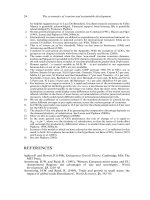THE ECONOMICS OF MONEY,BANKING, AND FINANCIAL MARKETS 357
Bạn đang xem bản rút gọn của tài liệu. Xem và tải ngay bản đầy đủ của tài liệu tại đây (32.99 KB, 1 trang )
CHAPTER 13
Banking and the Management of Financial Institutions
325
Just as you and I would be willing to pay an insurance company to insure us
against a casualty loss such as the theft of a car, a bank is willing to pay the cost
of holding reserves (the opportunity cost, the earnings forgone by not holding
income-earning assets such as loans or securities) to insure against losses due to
deposit outflows. Because reserves, like insurance, have a cost, banks also take
other steps to protect themselves; for example, they might shift their holdings of
assets to more liquid securities (secondary reserves).
Asset
Management
Now that you understand why a bank has a need for liquidity, we can examine
the basic strategy a bank pursues in managing its assets. To maximize its profits,
a bank must simultaneously seek the highest returns possible on loans and securities, reduce risk, and make adequate provisions for liquidity by holding liquid
assets. Banks try to accomplish these three goals in four basic ways.
First, banks try to find borrowers who will pay high interest rates and are
unlikely to default on their loans. They seek out loan business by advertising their
borrowing rates and by approaching corporations directly to solicit loans. It is up
to the bank s loan officer to decide if potential borrowers are good credit risks who
will make interest and principal payments on time (i.e., engage in screening to
reduce the adverse selection problem). Typically, banks are conservative in their
loan policies; the default rate is usually less than 1%. It is important, however, that
banks not be so conservative that they miss out on attractive lending opportunities that earn high interest rates.
Second, banks try to purchase securities with high returns and low risk. Third,
in managing their assets, banks must attempt to lower risk by diversifying. They
accomplish this by purchasing many different types of assets (short- and long-term,
government of Canada, and municipal bonds) and approving many types of loans
to a number of customers. Banks that have not sufficiently sought the benefits of
diversification often come to regret it later. For example, banks that had overspecialized in making loans to energy companies, real estate developers, or farmers
suffered huge losses in the 1980s with the slump in energy, property, and farm
prices. Indeed, some of these banks (e.g., the Canadian Commercial Bank and the
Northland Bank) went broke because they had put too many eggs in one basket.
Finally, the bank must manage the liquidity of its assets so that it can pay
depositors when there are deposit outflows without bearing huge costs. This
means that it will hold liquid securities even if they earn a somewhat lower return
than other assets. In addition, it will want to hold government securities so that
even if a deposit outflow forces some costs on the bank, these will not be terribly
high. Again, it is not wise for a bank to be too conservative. If it avoids all costs
associated with deposit outflows by holding only reserves, the bank suffers losses
because reserves earn little interest, while the bank s liabilities are costly to maintain. The bank must balance its desire for liquidity against the increased earnings
that can be obtained from less liquid assets such as loans.
Liability
Management
Before the 1960s, liability management was a staid affair: for the most part, banks
took their liabilities as fixed and spent their time trying to achieve an optimal mix
of assets. There were two main reasons for the emphasis on asset management.
First, a large part of the sources of bank funds was obtained through demand
deposits that did not pay any interest. Thus banks could not actively compete with
one another for these deposits, and so their amount was effectively a given for an
individual bank. Second, because the markets for making overnight loans between









